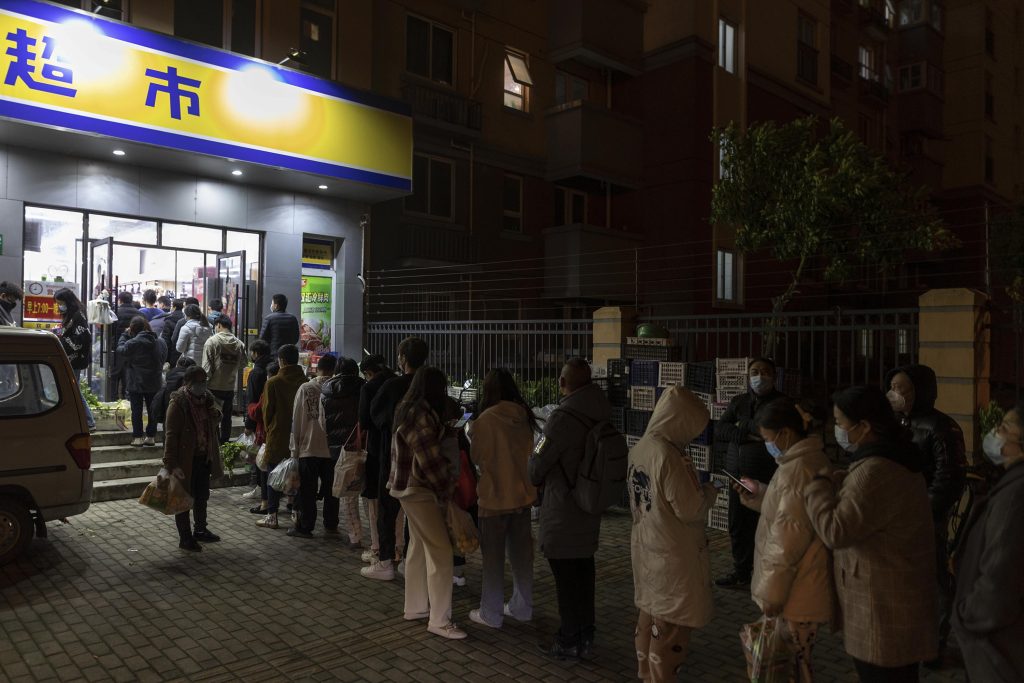BEIJING (AFP) – China began shutting down most of its major cities in Shanghai on Monday as the coronavirus spread amid questions about the economic toll of the country’s “zero COVID” strategy.
China’s financial capital, Shanghai has been relatively unaffected by the epidemic, with shutdowns limited to specific residential and workplace complexes. The two-stage citywide lockdown would be the most comprehensive in China since the central city of Wuhan, where the virus was first detected in late 2019, confining its 11 million residents to their homes at the start of the outbreak in 2020.
Shanghai’s Pudong Financial District and its vicinity will be closed from Monday to Friday as mass testing begins, the local government said. In the second phase of the lockdown, the vast downtown area west of the Huangpu River that then divides the city will begin a five-day lockdown on Friday.
Residents will be asked to stay at home and deliveries will be left at checkpoints to ensure there is no contact with the outside world. Offices and all businesses not considered essential will be closed and public transportation suspended.
Already, many communities within the city of 26 million people have been closed off over the past week, with their apartment complexes closed with blue and yellow plastic barriers, and residents required to undergo multiple tests for COVID-19. Shanghai Disneyland theme park is among the businesses that closed earlier. According to media reports, Automaker Tesla has also suspended production at its Shanghai factory.
And there were reports of panic buying on Sunday, as supermarket shelves were cleared of food, drinks and household items. Additional neighborhood barriers were erected Monday, with workers in hazmat suits at checkpoints.
Shanghai detected 3,500 more cases on Sunday, although all but 50 were people who tested positive for the coronavirus but did not show symptoms of COVID-19. While people who are asymptomatic can still infect others, China ranks such cases separately from “confirmed cases” – those in people who are sick – leading to lower totals in daily reports.
Nationwide, 1,219 new confirmed domestic cases of infection were detected on Sunday, more than 1,000 of which were in the northeastern province of Jilin, along with 4,996 asymptomatic cases, the National Health Commission reported Monday.
China has reported more than 56,000 confirmed cases nationwide this month, with the number of infections mostly increasing in Jilin.
Jilin Province is imposing travel bans and partial lockdowns in many cities, including Changchun, one of the centers of China’s auto industry. Although the county sees more than 1,000 new confirmed cases daily, the prevention and control measures taken there do not appear to have been as extreme as elsewhere.
China has described its long-standing “zero tolerance” approach as the most economical and effective prevention strategy against COVID-19.
The new measures being implemented in Shanghai are aimed at “reducing the spread of the virus, protecting people’s lives and health, and achieving the dynamic goal of eliminating COVID as soon as possible,” the city’s COVID-19 Prevention and Control Office said in an announcement Sunday evening. .
This requires lockdowns and mass testing, as close contacts are often isolated at home or at a central government facility. The strategy focuses on eliminating transmission of the virus in the community as quickly as possible.
While officials, including Communist Party leader Xi Jinping, have encouraged more targeted action, local officials tend to take a more extreme approach, worried they will be expelled or otherwise punished over accusations of failing to prevent the outbreak.
With China’s economic growth already slowing, the extreme measures are seen as exacerbating difficulties for employment, consumption and even global supply chains.
Although the vaccination rate in China is about 87%, it is much lower among the elderly.
National data released earlier this month showed that more than 52 million people aged 60 or older have not yet been vaccinated with any COVID-19 vaccine. Boost rates are also low, with only 56.4% of people aged 60-69 receiving a booster dose, and 48.4% of people aged 70-79 receiving one.

“Writer. Evil travel maven. Avid creator. Proud beer expert. Music lover. Explorer.”











More Stories
Jake Sullivan meets Yang Jiechi in Luxembourg, paving the way for a possible meeting between Biden and Xi
The CDC adds 3 places to its “high” risk list, including Mexico and the United Arab Emirates
Wordle 359 June 13 – Struggling with Wordle today? THREE CLUES TO HELP ANSWER | Games | entertainment